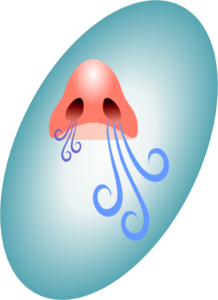Nostril dominance
Having two eyes allows me to perceive visual depth, and my two ears enable me to assess from which direction a sound is coming. Likewise, I can detect a wide range of smells by having two nostrils. However, the odor-sensing ability of each side of my nose is not symmetric, nor is the airflow in my two nostrils.
When I place a smartphone screen under my nostrils and breathe normally through my nose, the screen usually fogs up. As a result, two vapor stains collect under each nostril. In most cases, one stain will be larger than the other.
When I inhale or exhale through my nose, airflow usually differs from one nostril to the other. The common reasons for that difference are:
- Nose structure.
- Nasal congestion.
- Nasal tissue erection.
Nose structure
People are not 100% symmetric in all of their body parts. Some are born that way, and others develop asymmetries throughout their life. Injury may also cause unevenness. In some cases, the asymmetry is considerable and should be addressed.
When the partition between the two nostrils is not even or curved, air movement becomes uneven. That may cause a permanent airflow imbalance between the two nostrils or obstruction. Polyps or other swellings may also restrict airflow.
In many instances, correcting the asymmetric partition between the two nose parts or removing polyps is a relatively simple surgical procedure. However, it’s essential to determine if there are nasal structural faults and consider them when assessing airflow imbalance.
Congestion – running nose
A stuffy nose can affect airflow. In most cases, the trigger for swelling in the nose is an invasion of inhaled viruses or allergens. These cause blood vessel inflammation and the release of extra mucus. We often react by coughing, sneezing, and blowing the nose to clear the mucus and repel the invaders.
One of the remedies they used in the old days when having a chronic stuffy nose was ‘changing air’ by moving to a different geographical location with fewer triggers.
Pharmaceutical companies offer solutions for this situation, but other alternatives for reducing clogged airways are available; for example, flushing the nose with salt water, inhaling salty fumes, or inhaling steam.
Nasal tissue erection
Inside my nose, I have tissues that can expand or contract, similar to the erectile tissues of my sexual organs. My ‘breathing app’ controls enlargement and shrinkage. Furthermore, the tissues regulate airflow in each of my nostrils and can also block air movement. My ‘breathing app’ controls the duration of the restriction.
There is a slow and constant shift in the erection of tissues in the two nose sections. Most of the time, one nostril allows a more unrestricted airflow than the opposite one. The nostril where air moves relatively freely is called the dominant nostril. Intensive dominance is when it becomes difficult to breathe using only one nostril. Conversely, mild dominance is when its possible to maintain breathing via the restricted nostril.
Like the tides of an ocean, nostril dominance changes from one nostril to another and back again. It moves in cycles. The change occurs during different times of the day and under various hormonal, physical, and emotional circumstances. It changes every 20 minutes to 2 hours, and the shifting time may vary from cycle to cycle.
During the shifting, there is a particular interval with more or less equal dominance (same airflow in both nostrils). That is the period of balance, also called nostril equilibrium. The length of this equilibrium interval may differ from cycle to cycle.
Some suggest the dominant nostril side correlates with the dominant brain hemisphere, whereas right nostril dominance indicates the dominance of the left part of the brain and vice versa.
Checking dominance
An easy way I check my nostril dominance is by blocking one nostril using my finger and breathing exclusively through my other nostril. I then switch to the opposite nostril, do the same, and compare airflow intensity.
Sometimes I make a ‘quick check’ without using my fingers. I relax my nose muscles and then abruptly and forcefully inhale through my nose. The nostril that partially shuts is my dominant one, and if both nostrils close more or less evenly, it indicates equilibrium.
Breathing indications from my nose
I gather relevant indications by following my nostril dominance cycles, but I need to take into account that nose asymmetries or nose congestion may impact the indications. Occasionally, I check my nostril dominance in an effort to spot exceptions. For example, I do it when I have difficulties falling asleep, as I wake up, while experiencing stressful situations, or when I feel very relaxed. I’m trying to follow the patterns in which my nostril dominance swings.
Being a predominantly nose breather reduces the chances of having intensive dominance and irregular alternating intervals.
Balancing nostril dominance
- I breathe similarly to the exercise of Alternating nostril breathing.
- Block both my nostrils after an exhale, holding my breath and creating exhale pressure.
- Without a physical block, I visualize breathing freely from both nostrils, alternating from one to the other.
- Inhale similarly to the exercise of Nostril flaring breathing.
- Hum on the exhale, similar to the exercise of Humming bee breathing.
- Scratch my scalp with my fingernails and gently pull my hair on the opposite side of my dominant nostril.
- Apply pressure under my armpits using my hand or the back support of a chair. Hardcore Yogis use an apparatus in the shape of the letter T, sort of an underarm crutch. Applying pressure under the armpit on the same side as the dominant nostril speeds up the shifting.

